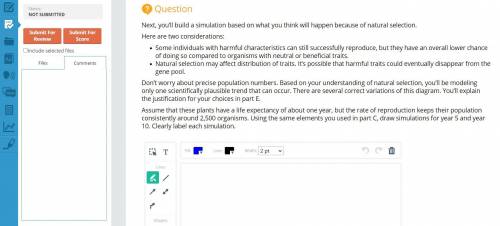
Biology, 14.02.2021 09:50 mmlordpepe9256
Next, you’ll build a simulation based on what you think will happen because of natural selection. Here are two considerations: Some individuals with harmful characteristics can still successfully reproduce, but they have an overall lower chance of doing so compared to organisms with neutral or beneficial traits. Natural selection may affect distribution of traits. It’s possible that harmful traits could eventually disappear from the gene pool. Don’t worry about precise population numbers. Based on your understanding of natural selection, you’ll be modeling only one scientifically plausible trend that can occur. There are several correct variations of this diagram. You’ll explain the justification for your choices in part E. Assume that these plants have a life expectancy of about one year, but the rate of reproduction keeps their population consistently around 2,500 organisms. Using the same elements you used in part C, draw simulations for year 5 and year 10. Clearly label each simulation.


Answers: 2
Another question on Biology

Biology, 21.06.2019 18:30
Describe the primary and secondary immune response in terms of speed and number of antibodies produced?
Answers: 3

Biology, 21.06.2019 21:30
The asian shore crab (hemigrapsus sanguineus) is an invasive species that has impacted the atlantic coast. predict what characteristic of this invader would most likely disrupt the biodiversity of this area.
Answers: 2

Biology, 21.06.2019 23:00
In some plants, pointed leaves (p) are dominant over rounded leaves (p). a plant with a genotype of pp
Answers: 2

Biology, 22.06.2019 01:30
Scenario 5 1) take 10 red and 10 black beans and place them, mixed, on the table. record the starting phenotype # and frequencies (% of your total population) of your starting population in the table provided (generation 0). 2) act as a predator. “capture” as many organisms as you can until you have reduced the population to three organisms. put them aside. at this point, the predators die. 3) the remaining organisms each produce 2 clonal offspring. multiply your organisms accordingly and allow them to mix on the table. calculate and record the resultant phenotype # and frequencies (% of your total population) of your population in the table provided (generation 1). 4) repeat the reproduction event, allowing each of your organisms to produce 2 clonal offspring. calculate and record the resultant phenotype # and frequencies (% of your total population) of your population in the table provided (generation 2). 5) repeat the reproduction event, allowing each of your organisms to produce 2 clonal offspring. calculate and record the resultant phenotype # and frequencies (% of your total population) of your population in the table provided (generation 3).
Answers: 1
You know the right answer?
Next, you’ll build a simulation based on what you think will happen because of natural selection. He...
Questions

Mathematics, 12.09.2021 20:10

Health, 12.09.2021 20:10


Physics, 12.09.2021 20:20

Mathematics, 12.09.2021 20:20


Mathematics, 12.09.2021 20:20

Social Studies, 12.09.2021 20:20




English, 12.09.2021 20:20

Mathematics, 12.09.2021 20:20


Computers and Technology, 12.09.2021 20:20







